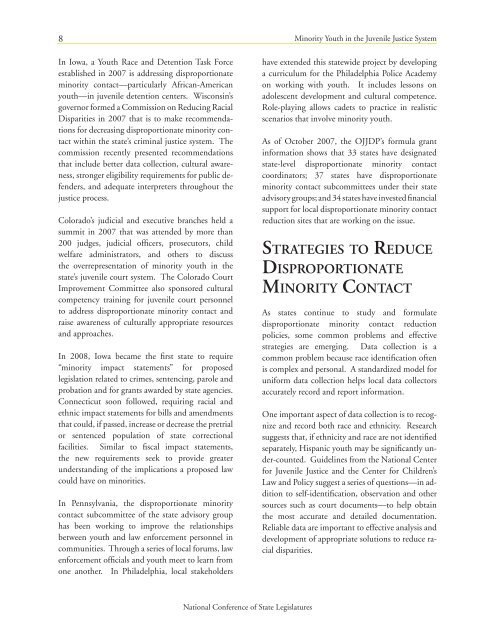African-American Youth in The Juvenile Justice System
African-American Youth in The Juvenile Justice System
African-American Youth in The Juvenile Justice System
Create successful ePaper yourself
Turn your PDF publications into a flip-book with our unique Google optimized e-Paper software.
8<br />
In Iowa, a <strong>Youth</strong> Race and Detention Task Force<br />
established <strong>in</strong> 2007 is address<strong>in</strong>g disproportionate<br />
m<strong>in</strong>ority contact—particularly <strong>African</strong>-<strong>American</strong><br />
youth—<strong>in</strong> juvenile detention centers. Wiscons<strong>in</strong>’s<br />
governor formed a Commission on Reduc<strong>in</strong>g Racial<br />
Disparities <strong>in</strong> 2007 that is to make recommendations<br />
for decreas<strong>in</strong>g disproportionate m<strong>in</strong>ority contact<br />
with<strong>in</strong> the state’s crim<strong>in</strong>al justice system. <strong>The</strong><br />
commission recently presented recommendations<br />
that <strong>in</strong>clude better data collection, cultural awareness,<br />
stronger eligibility requirements for public defenders,<br />
and adequate <strong>in</strong>terpreters throughout the<br />
justice process.<br />
Colorado’s judicial and executive branches held a<br />
summit <strong>in</strong> 2007 that was attended by more than<br />
200 judges, judicial officers, prosecutors, child<br />
welfare adm<strong>in</strong>istrators, and others to discuss<br />
the overrepresentation of m<strong>in</strong>ority youth <strong>in</strong> the<br />
state’s juvenile court system. <strong>The</strong> Colorado Court<br />
Improvement Committee also sponsored cultural<br />
competency tra<strong>in</strong><strong>in</strong>g for juvenile court personnel<br />
to address disproportionate m<strong>in</strong>ority contact and<br />
raise awareness of culturally appropriate resources<br />
and approaches.<br />
In 2008, Iowa became the first state to require<br />
“m<strong>in</strong>ority impact statements” for proposed<br />
legislation related to crimes, sentenc<strong>in</strong>g, parole and<br />
probation and for grants awarded by state agencies.<br />
Connecticut soon followed, requir<strong>in</strong>g racial and<br />
ethnic impact statements for bills and amendments<br />
that could, if passed, <strong>in</strong>crease or decrease the pretrial<br />
or sentenced population of state correctional<br />
facilities. Similar to fiscal impact statements,<br />
the new requirements seek to provide greater<br />
understand<strong>in</strong>g of the implications a proposed law<br />
could have on m<strong>in</strong>orities.<br />
In Pennsylvania, the disproportionate m<strong>in</strong>ority<br />
contact subcommittee of the state advisory group<br />
has been work<strong>in</strong>g to improve the relationships<br />
between youth and law enforcement personnel <strong>in</strong><br />
communities. Through a series of local forums, law<br />
enforcement officials and youth meet to learn from<br />
one another. In Philadelphia, local stakeholders<br />
M<strong>in</strong>ority <strong>Youth</strong> <strong>in</strong> the <strong>Juvenile</strong> <strong>Justice</strong> <strong>System</strong><br />
have extended this statewide project by develop<strong>in</strong>g<br />
a curriculum for the Philadelphia Police Academy<br />
on work<strong>in</strong>g with youth. It <strong>in</strong>cludes lessons on<br />
adolescent development and cultural competence.<br />
Role-play<strong>in</strong>g allows cadets to practice <strong>in</strong> realistic<br />
scenarios that <strong>in</strong>volve m<strong>in</strong>ority youth.<br />
As of October 2007, the OJJDP’s formula grant<br />
<strong>in</strong>formation shows that 33 states have designated<br />
state-level disproportionate m<strong>in</strong>ority contact<br />
coord<strong>in</strong>ators; 37 states have disproportionate<br />
m<strong>in</strong>ority contact subcommittees under their state<br />
advisory groups; and 34 states have <strong>in</strong>vested f<strong>in</strong>ancial<br />
support for local disproportionate m<strong>in</strong>ority contact<br />
reduction sites that are work<strong>in</strong>g on the issue.<br />
St r at e g i e s t o Re d u c e<br />
Di s p r o p o rt i o n at e<br />
M<strong>in</strong>ority Co n ta c t<br />
As states cont<strong>in</strong>ue to study and formulate<br />
disproportionate m<strong>in</strong>ority contact reduction<br />
policies, some common problems and effective<br />
strategies are emerg<strong>in</strong>g. Data collection is a<br />
common problem because race identification often<br />
is complex and personal. A standardized model for<br />
uniform data collection helps local data collectors<br />
accurately record and report <strong>in</strong>formation.<br />
One important aspect of data collection is to recognize<br />
and record both race and ethnicity. Research<br />
suggests that, if ethnicity and race are not identified<br />
separately, Hispanic youth may be significantly under-counted.<br />
Guidel<strong>in</strong>es from the National Center<br />
for <strong>Juvenile</strong> <strong>Justice</strong> and the Center for Children’s<br />
Law and Policy suggest a series of questions—<strong>in</strong> addition<br />
to self-identification, observation and other<br />
sources such as court documents—to help obta<strong>in</strong><br />
the most accurate and detailed documentation.<br />
Reliable data are important to effective analysis and<br />
development of appropriate solutions to reduce racial<br />
disparities.<br />
National Conference of State Legislatures

















